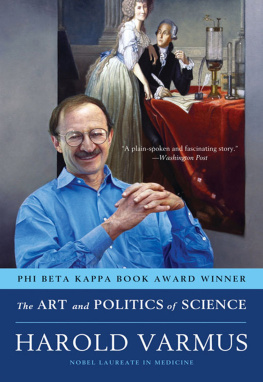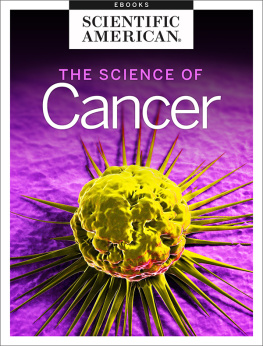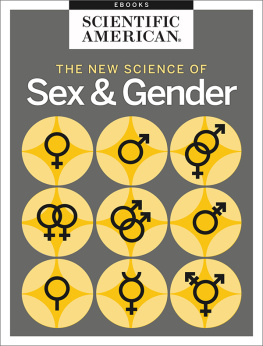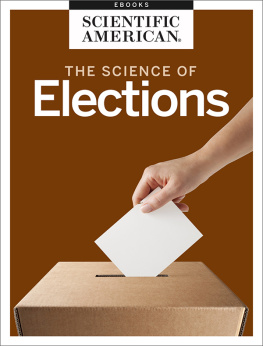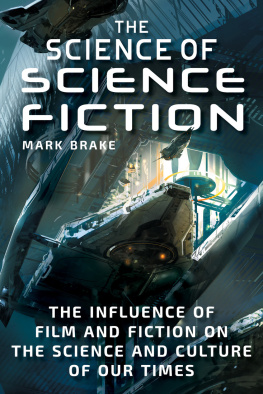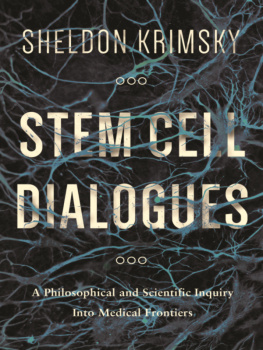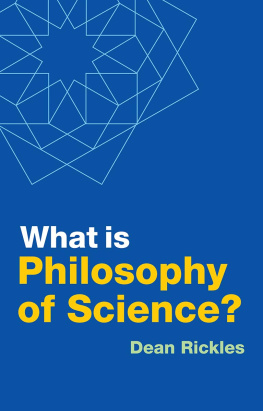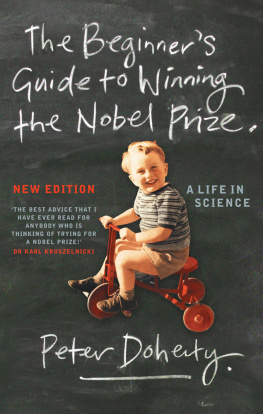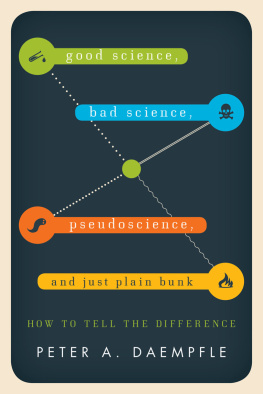W. W. NORTON & COMPANY
For information about permission to reproduce selections from this book, write to Permissions, W. W. Norton & Company, Inc., 500 Fifth Avenue, New York, NY 10110
Varmus, Harold.
The art and politics of science / Harold Varmus.1st ed.
p.; cm.
Includes bibliographical references.
ISBN: 978-0-393-07356-0
1. Varmus, Harold. 2. Medical scientistsUnited StatesBiography
3. Nobel Prize winnersUnited StatesBiography
4. National Institutes of Health (U.S.) I. Title.
[DNLM: 1. Varmus, Harold. 2. National Institutes of Health (U.S.)
3. ScienceUnited StatesPersonal Narratives. 4. Health PolicyUnited
StatesPersonal Narratives. 5. NeoplasmstherapyUnited
StatesPersonal Narratives. WZ 100 V316a 2009]
R154.V47.A3 2009
610.92dc22
W. W. Norton & Company, Inc.
500 Fifth Avenue, New York, N.Y. 10110
www.wwnorton.com
W. W. Norton & Company Ltd.
Castle House, 75/76 Wells Street, London W1T 3QT
Preface
T HIS SMALL BOOK OWES ITS EXISTENCE IN LARGE PART TO JEAN STROUSE. Late in 2003, when she was still the freshly appointed director of The New York Public Librarys Cullman Center for Scholars and Writers, Jean asked me to give a series of three lectures the following fall, an annual event sponsored by W. W. Norton & Company, hoping that I would speak about some aspects of the relationship between the sciences and the humanities. This notion was inspired, in part, by her long-range goal of using her new position to promote a greater interest in and knowledge about science among her colleagues in the humanities. I was asked because she knew that I had studied literature in earlier years and continue to read widely in realms beyond the science that I practice.
At first, she suggested that I revisit the concept of two cultures, which is generally traced to the 1959 Rede Lecture delivered by C. P. Snow, who had achieved prominence as a scientist, a novelist, and a government official. Snows description of the two cultures, the arts and the sciences, separated by a gulf of language and thought, met with both hearty acclaim and strident criticism, and the subsequent debates attracted enormous attention. (I recall an evening given over to an American version of the debate at a fraternity house at Amherst College in 1960, when I was an undergraduate there.)
But on rereading both the original lecture and Snows responses to his critics, I found (and Jean did too) that the idea of two cultures now appeared too simplistic, however accurate, to bear a lengthy reexamination. So, after a series of lunches and email exchanges, we agreed that I would endeavor to explain what it means to be a scientistor, anyhow, what it has meant for me to be a scientist. That seemed to be a way to fulfill at least part of her original purpose, since I came to science through an education in the humanities, and my career as a scientist has included significant forays into politics, administration, publishing, and international issues. By defining my purpose in this manner, I hoped to make some aspects of the life and thoughts of one scientist intelligible and possibly interesting to even the most entrenched members of the other culture.
To do this, I intended to use my three lectures to describe three things: first, how I became a scientist; then, something about the work my colleagues and I have done and its significance for the control of cancer; and, finally, examples of my experience in government and policy-making, to offer a view of a scientist in a larger world that includes politics and the arts. The assignment encouraged me to think more than I would otherwise have done about the shape of my career, which revealed to me how meandering and unexpected it has been. This themewith implicit course changes and serendipitiesbecame a dominant one in the lectures and even more so in this volume.
Still, the two cultures also remained a recurring theme. In the first lecture, I described myself veering from one culture to the other, while seeking a career. In the second, I tried to make my scientific work comprehensible, in what seemed to be a very short hour, to listeners accustomed to talks on the humanities. In the course of the final lecture, one dealing with the intersections of science and politics, I recalled the real purpose of Snows lectures: to ask which element in our culture was most likely to help those countries struggling with poverty.
To undertake the Norton lectures, I also had to agree to turn them into a book, happily to be published by the sponsor and edited by its president, Drake McFeely. I have taken advantage of the less restrained format of a book to describe some of my scientific work in greater detail than was possible in the second lecture and to expand on the political and social themes of the final lecture.
Despite the inclusion of additional material, this book is certainly very far from being a full autobiography; it does not pretend to be a comprehensive account of my work either as a scientist in a laboratory or as a scientist engaged in politics. I have tried to select aspects of my scientific work and of my life as a leader of institutions that would interest a general reader, without concern for any sense of completeness. Still, the process of selection has been difficult and anxiety provoking. In writing about my scientific work, I have followed only a couple of threads in the fabric of what my research group has tried to achieve. In doing so, I have omitted several topicsand, more awkwardly, many peoplecentral to my experience as a scientist. At the same time, while trying to convey a coherent story about the field of modern cancer research, and hoping to illustrate the kinds of experience that science offers as well as some of its intellectual rewards, I have left out significant aspects of our field and many people whose work has been extraordinary. Happily, more inclusive treatments of recent progress in cancer research can be found elsewhere; some are cited in the bibliography. I hope that those who feel that they have been sidelined or that crucial topics have been ignored will have some sympathy for my plight and some affinity for my objectives.
The process of writing about myself, for the lectures or the book, has been awkward and slow. In July of 2004, a few months before my lectures, I happened to be in Paris on the occasion of a popular exhibition entitled Moi!a collection of self-portraits by twentieth-century painters and photographers, housed in the Luxembourg Palace. Such portraits are not hard to find; artists appear to be attracted to themselves as subjects. Self-portraits by scientists, however, are uncommon. An exceptional few, like Franois Jacobs The Statue Within , are intensely personal and emotionally revealing. can painter Norman Rockwell, the working methods of the painter, his efforts at objectivity, are the focal point of the portrait. Rockwell has, in fact, portrayed himself as a kind of scientist, using a technical device, a mirror, to observe and measure, and thus to help record his appearance in paint on canvas. I hope to emulate his approach in the pages that follow.

